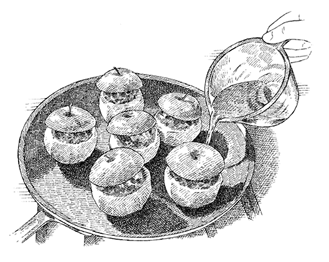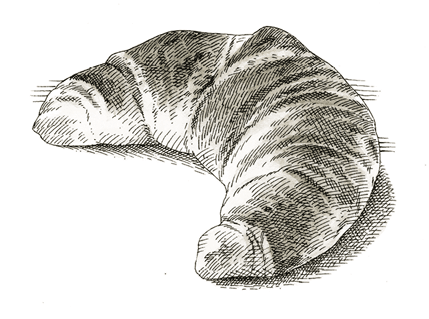The Cook's Illustrated Cookbook (352 page)
Read The Cook's Illustrated Cookbook Online
Authors: The Editors at America's Test Kitchen
Tags: #Cooking


1.
Slicing off tops allows for generous room for filling and removing entire peel for base prevents blowouts and keeps flesh firm.

2.
Sautéing apples in butter before baking contributes rich, caramelized flavor.

3.
Capping apples with sliced-off tops shields filling from burning in oven.
![]() WHY THIS RECIPE WORKS
WHY THIS RECIPE WORKS
Most fruit salads betray neither rhyme nor reason regarding the fruit selection or assembly, and the customary heavy sprinkling of sugar seems designed to mask defects in the fruit. We set out to rewrite the rules of fruit salad to bring out the best fruit flavor. We cut the fruit into small, uniform pieces, so the different flavors and textures could come through in each mouthful. To keep each fruit distinct, we also limited the number to three per salad. We found it hard to judge the proper amount of sugar when it was added directly to the salad, so we macerated each fruit in just the amount needed to release the fruits’ natural juices; we also balanced the sweetness with fresh lime juice. But first, we mashed the sugar with herbs and zests (in bartending circles, this process is called “muddling”) to ensure even flavor distribution.
SERVES 4 TO 6
The optional cayenne adds a bit of heat to this fruit salad.
4 | teaspoons sugar |
2 | teaspoons grated lime zest plus 1 to 2 tablespoons juice |
Pinch cayenne (optional) | |
3 | cups honeydew melon, cut into ¹⁄ |
1 | mango, peeled, pitted, and cut into ¹⁄ |
1–2 | teaspoons grated ginger |
5 | ounces (1 cup) raspberries |
Combine sugar, lime zest, and cayenne, if using, in large bowl. Using rubber spatula, press mixture into side of bowl until sugar becomes damp, about 30 seconds. Gently toss honeydew, mango, and ginger to taste with sugar mixture until combined. Let sit at room temperature, stirring occasionally, until fruit releases its juices, 15 to 30 minutes. Gently stir in raspberries. Stir in lime juice to taste and serve.
SERVES 4 TO 6
Blueberries can be substituted for the cherries.
4 | teaspoons sugar |
1–2 | tablespoons minced fresh mint |
¹⁄ | teaspoon vanilla extract |
3 | cups cantaloupe, cut into ¹⁄ |
2 | plums, halved, pitted, and cut into ¹⁄ |
8 | ounces fresh sweet cherries, pitted and halved |
1–2 | tablespoons lime juice |
Combine sugar and mint to taste in large bowl. Using rubber spatula, press mixture into side of bowl until sugar becomes damp, about 30 seconds; add vanilla. Gently toss fruit with sugar mixture until combined. Let sit at room temperature, stirring occasionally, until fruit releases its juices, 15 to 30 minutes. Stir in lime juice to taste and serve.
SERVES 4 TO 6
Nectarines can be substituted for the peaches.
4 | teaspoons sugar |
2 | tablespoons chopped fresh basil |
¹⁄ | teaspoon pepper |
3 | peaches (6 ounces each), halved, pitted, and cut into ¹⁄ |
10 | ounces (2 cups) blackberries |
10 | ounces strawberries, hulled and quartered lengthwise (2 cups) |
1–2 | tablespoons lime juice |
Combine sugar, basil, and pepper in large bowl. Using rubber spatula, press mixture into side of bowl until sugar becomes damp, about 30 seconds. Gently toss fruit with sugar mixture until combined. Let sit at room temperature, stirring occasionally, until fruit releases its juices, 15 to 30 minutes. Stir in lime juice to taste and serve
MIMICKING AGED BALSAMIC
Traditionally produced balsamic vinegar (labeled tradizionale) is used sparingly for drizzling or flavoring—never in salad dressings or vinaigrettes. It can take over 25 years to produce and can cost up to $60 per ounce. We wanted to find a way to reproduce some of the drizzle-worthy qualities of traditional balsamic without having to visit a specialty food store or a loan officer.
We started with a decent supermarket balsamic vinegar and tried reducing it with sugar and flavorings ranging from black currant juice to coffee. In the end, we found that a straight reduction of ¹⁄
3
cup of vinegar and 1 tablespoon of sugar worked well enough, but the addition of 1 tablespoon of port added the complexity we were after. Vigorous boiling destroyed nuances in the vinegar’s flavor; the best results came from reducing this mixture for 30 to 40 minutes over extremely low heat (barely simmering) to about half of its original volume. While most tasters could distinguish this reduction from a traditional 12-year-old balsamic, our homemade drizzling vinegar was surprisingly good. The flavor is very strong, so use sparingly over fresh fruit (strawberries are terrific), ice cream, or grilled meats or fish.

![]() WHY THIS RECIPE WORKS
WHY THIS RECIPE WORKS
Pâte à choux, or cream puff pastry, is the most elemental type of French pastry, and it forms the basis for éclairs and profiteroles. In our pâte à choux, we chose to use a combination of milk and water—during baking, the former helps the pastry brown and the latter keeps it crisp. Testing revealed that 2 whole eggs plus 1 egg white made incredibly light, airy pastry with custardy interiors.
MAKES ENOUGH FOR 8 ÉCLAIRS OR 24 PROFITEROLES
Be sure to sift the flour after measuring.
2 | large eggs plus 1 large white |
6 | tablespoons water |
5 | tablespoons unsalted butter, cut into 10 pieces |
2 | tablespoons whole milk |
1¹⁄ | teaspoons sugar |
¹⁄ | teaspoon salt |
¹⁄ | cup (2¹⁄ |
1.
Beat whole eggs and egg white together in liquid measuring cup; set aside. Bring water, butter, milk, sugar, and salt to boil in small saucepan over medium heat. Remove saucepan from heat and stir in flour until combined and mixture clears sides of pan. Return saucepan to low heat and cook, stirring constantly, using smearing motion, until mixture is slightly shiny with wet-sand appearance and tiny beads of fat appear on bottom of saucepan, about 3 minutes (mixture should register 175 to 180 degrees).
2.
Immediately transfer hot mixture to food processor and process for 10 seconds to cool slightly. With food processor running, gradually add beaten eggs in steady stream. Scrape down sides of bowl, then process for 30 seconds until smooth, thick, sticky paste forms. (Paste can be transferred to bowl, surface covered with plastic wrap that has been sprayed with vegetable oil spray, and stored at room temperature for up to 2 hours.)
